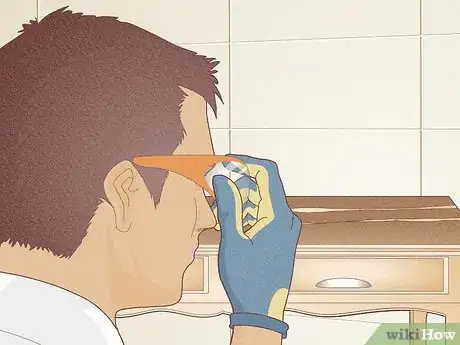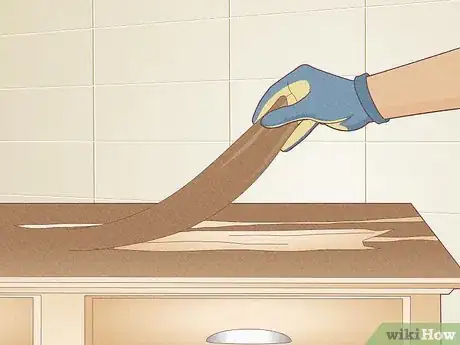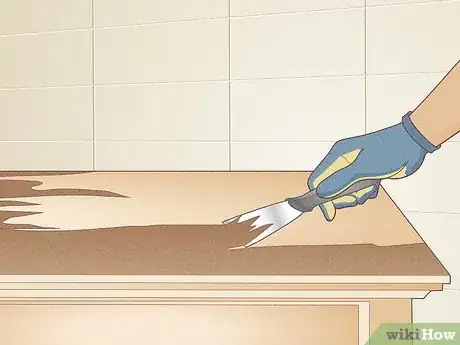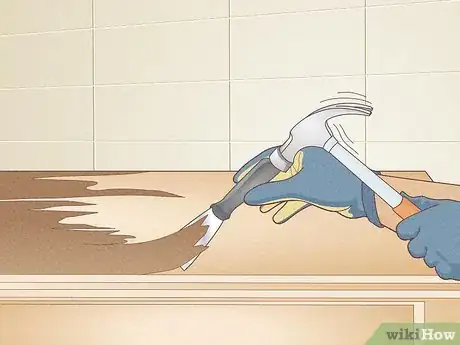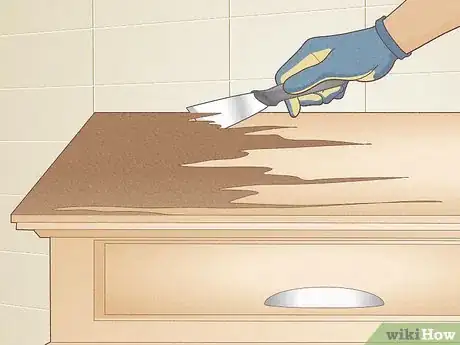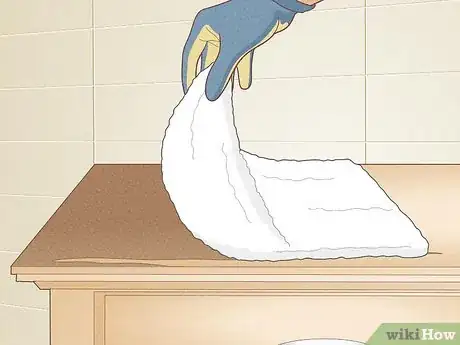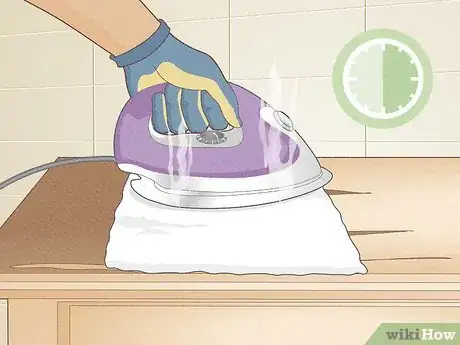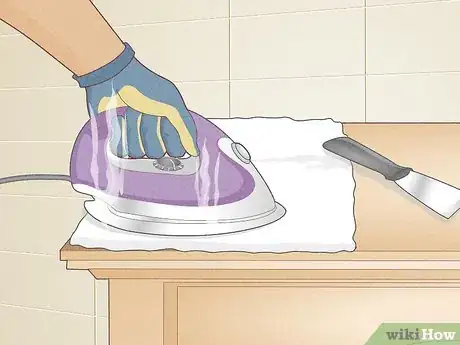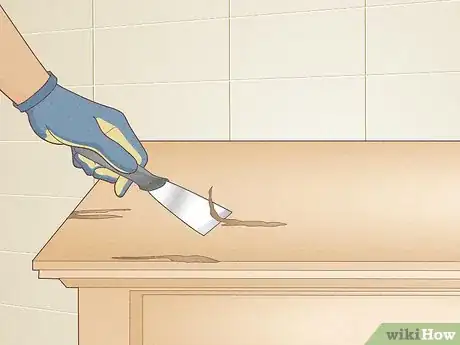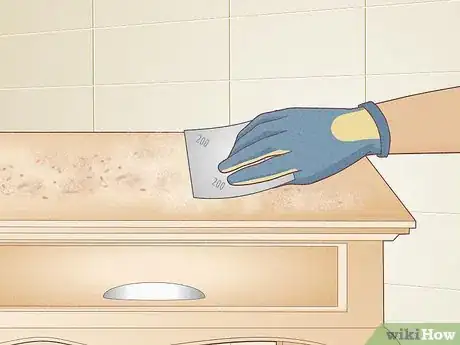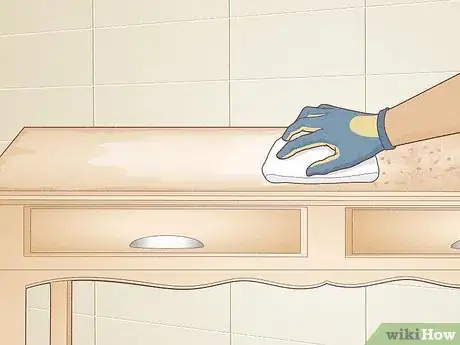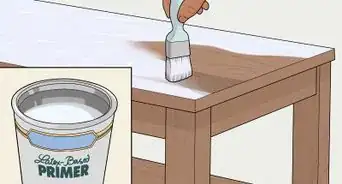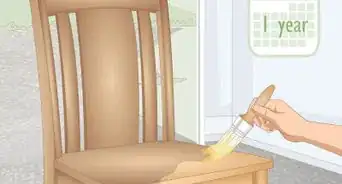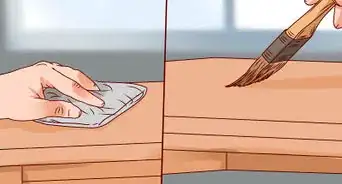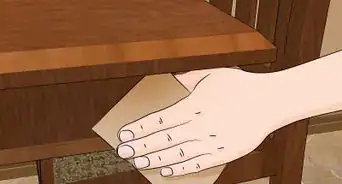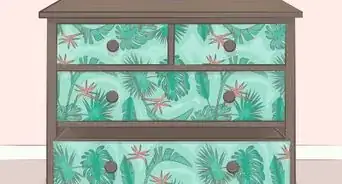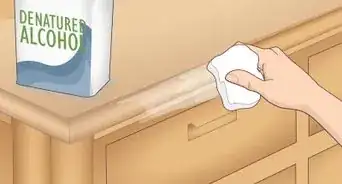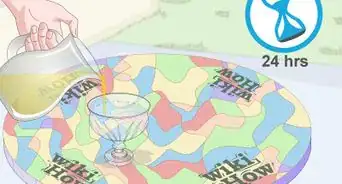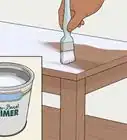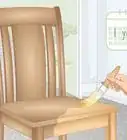This article was co-authored by wikiHow Staff. Our trained team of editors and researchers validate articles for accuracy and comprehensiveness. wikiHow's Content Management Team carefully monitors the work from our editorial staff to ensure that each article is backed by trusted research and meets our high quality standards.
There are 11 references cited in this article, which can be found at the bottom of the page.
This article has been viewed 24,967 times.
Learn more...
Many wood pieces and furniture are covered with veneer sheets for some extra decoration. It looks nice, but it’s a real pain if you want to get it off and redecorate the piece. Luckily, the removal process is pretty easy. The only catch is that it’s time-consuming, so set aside a few hours to get this done. With some scraping, heating, and patience, you can get rid of all the veneer and redecorate the piece however you want to.
Steps
Scraping off Loose Pieces
-
1Put on gloves and goggles to protect yourself. Veneer is sharp and could cut you, so wear a heavy pair of work gloves to protect your hands. Also put goggles on, because the scraping could send debris into the air.[1]
- You usually don't need a dust mask for this part. However, if you have any breathing troubles or the piece is especially dusty, then wear one.
-
2Pull up any loose sheets by hand if you can. If you’re working on an old piece of wood, then some veneer might be peeling off on its own already. In this case, just try to grab any loose part and pull them off. This will give you less work to do later on.[2]
- Don’t worry about getting the veneer off in full sheets. It’ll break while you’re pulling it off, so don’t be gentle.
- The veneer might not have any loose spots, so don’t worry if you can’t pull any up by hand.
Advertisement -
3Insert a putty knife under the veneer to lift it up. Find a point where the veneer is lifting up a little, which is usually along the edge or corner of the wood. Hold the putty knife so it’s parallel with the piece of wood. Then work the knife under the veneer and lift to scrape it up.[3]
- Keep the knife as parallel with the wood as you can. If you point it down, you could damage the wood under the veneer.
- If you want to avoid damaging the wood underneath, use a plastic scraper instead.[4] Keep in mind this might not lift the veneer as well as a metal putty knife.
-
4Tap the putty knife with a hammer to help get it under stubborn spots. There might be spots with tougher glue where you can’t get the knife in. In this case, try tapping the back of the putty knife with a hammer. This can give you an extra boost to break the veneer off.[5]
- Only hit the knife lightly. If the veneer still won’t budge, then don’t force it or you might damage the wood.
-
5Scrape off as much veneer as you can with the putty knife. Continue working around the piece of wood with the putty knife and pull off as much as you can. Depending on how old the piece is, you might be able to get a lot of veneer off by hand like this.[6]
- If the piece is very old and the veneer is falling off, then you might even get it all off with just the scraper.
- Don’t worry if you can’t get all the veneer off this way. Just get off the loose pieces to start with.
Using Heat for Tough Spots
-
1Place a damp towel on veneer that won’t come loose. It’s very likely that you’ll hit some spots where the glue is too tough and you can’t get the veneer up. In this case, you can loosen the glue with heat and moisture. Start off by wetting a towel and wringing it out. Then cover the trouble spot with the towel.[7]
- Make sure the towel isn’t soaked or you might damage the wood under the veneer.
- Some people also recommend melting the glue with a hair dryer or heating gun, though the results are more mixed.
-
2Hold a hot iron against the towel for 30 seconds. Put the iron on its hottest setting and let it heat up. Then press it down onto the towel. Hold the iron in place for 30 seconds to melt the veneer glue.[8]
- You don’t need to put water in the iron. The towel provides all the moisture you need.
- On most irons, the hottest setting is also the linen setting, if you need a reference.
-
3Scrape off the wet veneer with the putty knife. Once the glue is melted, the veneer should come up much easier. Take off the towel and give it another scrape to get it off.[9]
- If you still have trouble getting the veneer up, just heat it again. The glue might need some extra melting.
- Don’t let the veneer cool off first. The glue might harden again.
-
4Repeat this process for any tough veneer spots. Continue working around the wood and heating up any spots that won’t come up. Then scrape them off with the putty knife until the piece of wood is totally bare.[10]
- Re-wet the towel when it starts drying out. Otherwise it might burn. Remember to wring it out.
-
5Keep stuck veneer wet for a whole day to dissolve the glue. Veneer doesn’t always cooperate, especially newer pieces with strong glue. If the heating trick doesn’t get all the veneer off, then try wetting a towel and leaving it on the wood for an entire day. This should dissolve the glue. Then remove the towel and scrape again to get the leftover veneer off.[11]
- Re-wet the towel throughout the day if it starts drying out. Remember to wring it out first so you don't soak the wood.
Sanding and Cleaning the Wood
-
1Scrape off any leftover veneer glue with your putty knife. There might still be some clumps of clear glue around the wood when you get all the veneer off. Look around the piece and use your putty knife to scrape it all off so you have a nice even surface.[12]
- If any stubborn pieces of glue won’t come off, heat them up to loosen them. Then scrape them again.
-
2Sand the piece of wood with 80-grit sandpaper to get rid of rough spots. Sand in a smooth, back-and-forth motion around the whole piece. This should take care of any leftover glue or rough patches on the wood.[13]
- Wear a dust mask or respirator while you’re sanding so you don’t inhale any dust and cough.
- If you’re working on a larger piece of wood, you can use an electric sander to make the job go by faster.
-
3Smooth out the surface with 200-grit sandpaper. Switch to this fine-grit sandpaper and sand the piece again. This will smooth out the surface and get rid of any imperfections you made while removing the veneer.[14]
-
4Wipe down the wood with a damp cloth to remove sawdust. The scraping and sanding create a lot of sawdust. Use a damp rag or tack cloth and wipe down the whole piece to get rid of all this leftover debris.[15] Then you can go on with redecorating the piece if you want to.
Community Q&A
-
QuestionI removed veneer from a tabletop and found crumbly MDF underneath. Should I keep digging?
 ZackTop AnswererNo. It may be possible that the tabletop is too decayed to be restored. You will need to be sure that the MDF substrate will not continue to crumble beneath the new veneer. If the crumbling is just a small area, you may want to attempt a repair. If the entire project is crumbling, you may need to discard it.
ZackTop AnswererNo. It may be possible that the tabletop is too decayed to be restored. You will need to be sure that the MDF substrate will not continue to crumble beneath the new veneer. If the crumbling is just a small area, you may want to attempt a repair. If the entire project is crumbling, you may need to discard it.
Things You'll Need
- Putty knife
- Water
- Towels
- Hammer
- Iron
- 80 and 200-grit sandpaper
References
- ↑ https://youtu.be/-ttXq3Y8lG4?t=200
- ↑ https://salvagedinspirations.com/how-to-remove-veneer/
- ↑ https://salvagedinspirations.com/how-to-remove-veneer/
- ↑ https://youtu.be/-ttXq3Y8lG4?t=111
- ↑ https://salvagedinspirations.com/how-to-remove-veneer/
- ↑ https://youtu.be/-ttXq3Y8lG4?t=210
- ↑ https://youtu.be/-ttXq3Y8lG4?t=247
- ↑ https://youtu.be/8QMC0aRSyi8?t=31
- ↑ https://youtu.be/8QMC0aRSyi8?t=39
